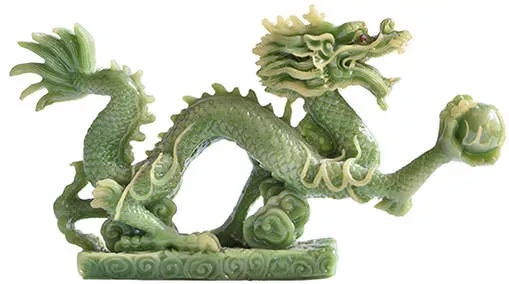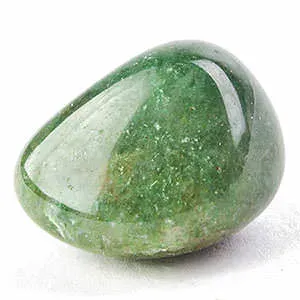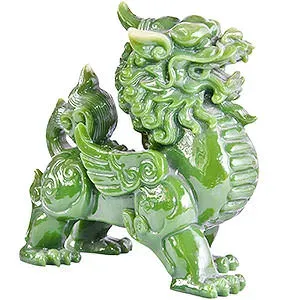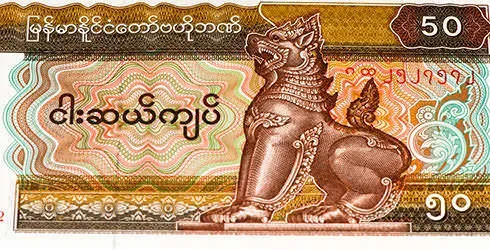 Jade is the stone given in celebration of the 12th, 30th, and 35th anniversaries of marriage. For thousands of years, the stone has been revered in China and other countries throughout the world. The Chinese, Mayas, Aztecs, and the Maoris of New Zealand have long prized the stone for its use in jewelry, and in carvings of sacred religious figures. Before there were written records of jade, it was used for axe heads, spear points, daggers, and sacred knives in pagan religious ceremonies. From the earliest days of jade's history, it has been the most favored gem among the Chinese. There are collections of jade with Chinese carvings, dating back to 2000 BC in museums throughout the world. These include carvings of meaningful shapes such as fish, birds, bats and dragons. Jade was used extensively in daily and ceremonial objects of Chinese nobility and represented high rank and authority. Jade amulets were actually buried with the dead in China. The Spanish conquistadores adopted the use of jade when they invaded Central America. They often wore amulets made from the stone. Jade was also used by Ancient South American cultures in ornamental objects and as axe heads. The ancient Mexican hieroglyph for precious stones actually refers primarily to jade. Maori tribes in New Zealand made their legendary war clubs and ceremonial carvings out of jade. The Spanish conquistadores called jade piedra de hijada (loin stone) or piedra de los rinones (kidney stone), believing it prevented or cured ailments in those areas.
Jade is the stone given in celebration of the 12th, 30th, and 35th anniversaries of marriage. For thousands of years, the stone has been revered in China and other countries throughout the world. The Chinese, Mayas, Aztecs, and the Maoris of New Zealand have long prized the stone for its use in jewelry, and in carvings of sacred religious figures. Before there were written records of jade, it was used for axe heads, spear points, daggers, and sacred knives in pagan religious ceremonies. From the earliest days of jade's history, it has been the most favored gem among the Chinese. There are collections of jade with Chinese carvings, dating back to 2000 BC in museums throughout the world. These include carvings of meaningful shapes such as fish, birds, bats and dragons. Jade was used extensively in daily and ceremonial objects of Chinese nobility and represented high rank and authority. Jade amulets were actually buried with the dead in China. The Spanish conquistadores adopted the use of jade when they invaded Central America. They often wore amulets made from the stone. Jade was also used by Ancient South American cultures in ornamental objects and as axe heads. The ancient Mexican hieroglyph for precious stones actually refers primarily to jade. Maori tribes in New Zealand made their legendary war clubs and ceremonial carvings out of jade. The Spanish conquistadores called jade piedra de hijada (loin stone) or piedra de los rinones (kidney stone), believing it prevented or cured ailments in those areas.
 The Chinese believed that since jade objects lasted so long, they were linked to immortality. They believe jade to also bring good luck, benevolence, purity, and enhanced intelligence. In the West, jade is thought to be a stone that can help the wearer be more relaxed and calm. Overall, jade has always been said to bring its owner power, knowledge, pure thoughts and long life. There are many beliefs in jade's healing influences- especially in healing ailments of the eyes, nervous system, and organs, especially the kidneys. It used to be worn in amulets over the kidney area, as well as on the arm.
The Chinese believed that since jade objects lasted so long, they were linked to immortality. They believe jade to also bring good luck, benevolence, purity, and enhanced intelligence. In the West, jade is thought to be a stone that can help the wearer be more relaxed and calm. Overall, jade has always been said to bring its owner power, knowledge, pure thoughts and long life. There are many beliefs in jade's healing influences- especially in healing ailments of the eyes, nervous system, and organs, especially the kidneys. It used to be worn in amulets over the kidney area, as well as on the arm.
 Jade rates a 6-7 on the hardness scale. It is an extremely strong stone and resists breakage like no other stone. The color of jade can range from shades of green and blue, to yellow, red, white, lavender, gray, and black. Jade is never completely transparent but the closer the stones come to being translucent, the more value they have. In fact, very fine, almost transparent white jade can be of equal value to a
Jade rates a 6-7 on the hardness scale. It is an extremely strong stone and resists breakage like no other stone. The color of jade can range from shades of green and blue, to yellow, red, white, lavender, gray, and black. Jade is never completely transparent but the closer the stones come to being translucent, the more value they have. In fact, very fine, almost transparent white jade can be of equal value to a ![]() diamond. Collectors of green jade which is almost
diamond. Collectors of green jade which is almost ![]() emerald in color, along with fine blue jade, prize the stones as much as any other precious stone. Jade is found in metamorphic rocks and as alluvial pebbles or boulders.
emerald in color, along with fine blue jade, prize the stones as much as any other precious stone. Jade is found in metamorphic rocks and as alluvial pebbles or boulders.
 The most important source of jade is Myanmar, which has supplied China with translucent imperial jade (the most prized variety of jade) for over 200 years now. Historically, Guatemala was an important source of jade, providing the stone for the carvings of the Central American Indians. Jade can also be found in Central Asia, Canada, Australia, Northern Burma, Siberia, New Zealand, Japan, and in the US- in California, Alaska, and Wyoming. The best way to care for jade is by cleaning it with mild soap and warm water, using a soft cloth to dry it immediately after washing. Avoid any exposure to hard blows, or any type of chemicals.
The most important source of jade is Myanmar, which has supplied China with translucent imperial jade (the most prized variety of jade) for over 200 years now. Historically, Guatemala was an important source of jade, providing the stone for the carvings of the Central American Indians. Jade can also be found in Central Asia, Canada, Australia, Northern Burma, Siberia, New Zealand, Japan, and in the US- in California, Alaska, and Wyoming. The best way to care for jade is by cleaning it with mild soap and warm water, using a soft cloth to dry it immediately after washing. Avoid any exposure to hard blows, or any type of chemicals.